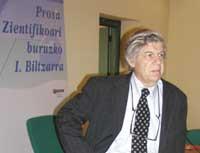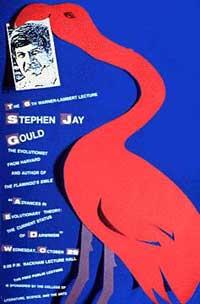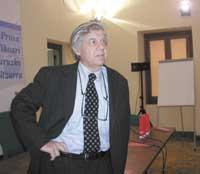Stephen J. Gould: ‘storytelling’ of science
2002/01/01 Imaz Amiano, Eneko - Elhuyar Zientziaren Komunikazioa Iturria: Elhuyar aldizkaria
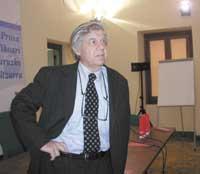
A paleontologist born in New York 60 years ago and currently the best-known professor at Harvard University. Despite her work on many other things, the “This View of Life” column of Natural History magazine, edited by the Natural History Museum of America, has been popularized by the writings monthly for the last 25 years. With his collections he has written several well-known books (“Despues de Darwin”, “Irripar del flamenco”, “El pulgar de Panda”…). One of the reasons for its success is that, despite being in a scientific journal, it is written in the way that is understandable to the general public, among other things because it uses street examples.
But Gould is also a scientist with great contributions in the field of evolution and human intelligence. The neo-Darwinian theory of evolution, which she considers a model of strict adaptation to the evolution of human cognitive abilities, was strongly criticized (let alone creationism) and in 1972, along with Niles Eldredge, she published the theory of ‘taiduna equilibrium’. According to this theory, evolution is not due to slow adaptations, but rather to abrupt changes. He considers that evolution is discontinuous, since specialization is due to events that occurred in a short period of time.
We have had the opportunity to talk to Stephen Jay Gould and here we leave the things he told us.
It is known, among other things, that before launching the theory of taiduna equilibrium, Darwin's theory of evolution was the most accepted to explain the history of life, but there were other points of view (neutralism, non-adaptive evolution, neodarwinism...). At the time of launching the theory of taidarra equilibrium he was very successful, but the debates did not end, they continued, and he is surprised to wonder if this had only increased the confusion. To a certain extent, he has said that it may be so, “but life is complex and in things as complex as the history of life we could not expect there to be a single simple mechanism to explain it.”
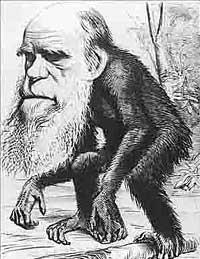
He does not believe that “mechanisms such as natural selection that adapts the organism, or processes of slow change that will occur over time to achieve great changes, or processes of accumulation of small changes, can explain this complex system”. He has said that it can be a difficult job to combine all the explanations, but although he has no problems with Darwin's natural selection, he does not seem enough to explain the history of life.
Nevertheless, we have explained to him that the theory of Darwin's evolution is taught at school and that in order to know other theories (neutralism, non-adaptive evolution, neo-Darwinism, creationism or aúd balance) we have to go to university. Therefore, we have mentioned that it can be concluded that some theories are ignored by others or that Darwin's theory is a good starting point for understanding others.
He, however, disagrees with the idea of abandonment. For him, Darwin’s theory explains many things, among other things, why organisms are so well adapted to the environment at every moment or why hands work, but, for example, he sees the need for another type of evolution that explains the nature of the genome or the existence of infinite copies of genes or neutral copies of genes, “it is not Darwin’s natural selection.” However, in teaching evolution in schools for the first time, he says that Darwin's theory is a good starting point, because that is the core.
Evolution is not predictable and does not ensure its duration
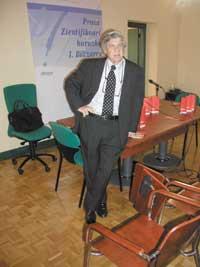
It can be said that it was the I Scientific Prose organized by the EIE. Congress S. J. Gould wanted to spread the message. He said that we can try to explain and understand the facts of the history of life, but that we can never announce them, neither we nor the rest of the living beings. Was it foreseeable that an asteroid hit the Earth and the dinosaurs disappeared? Until then they adapted very well and were well adapted to the medium, but this did not guarantee their duration. Therefore, he affirmed, among other things, that, according to the most accepted theory of today, if the asteroid that caused the disappearance of the dinosaurs had not collided with the Earth, the dinosaurs were still here and the mammals would remain small. This belief was also reaffirmed in the dialogue, but if that is not a prediction, he laughs and “Well, yes... you can never be sure, but in the 130 million years that were here, only 65 million years have disappeared, they adapted very well and I see no reason for them to disappear. You can’t say sure, of course.”
Between Darwin and the tacit equilibrium we have mentioned three significant or outstanding differences. The first can be a temporary scale. And in this respect, the first problem is that of the temporal geological scale. And it is that people find it difficult to understand this scale, “professionals also make mistakes constantly, because we always measure it with the scale of our life, with a longevity of 70-80 years. It is impossible to think in terms of millions of years.” For example, he considers that tadun balance is not a theory of abrupt changes, but a theory of how speciation works (how new species are created by isolating groups, separating them from the origin group and evolving). “Since this speciation can be millennial, changes in tacit balance can also seem extremely slow, as slow as in gradualism, but if we turn to geological data and see that a specific speciation spans 3,000 years, this is a sudden change.”
The second difference can be that of the point of view, since Darwin’s evolution is often interpreted as an adaptation to an objective, to a directionality or to an improvement… “Better, but only in the local environment, a typical mix that people do many times”. Darwin talks about getting around and believes that people are wrong because people see it as an improvement in life history, but it's not really that. “This is only a theory about improving adaptation to the nearby environment, which does not necessarily require change. Darwin's evolution has no directionality or predictability, it is simply to adapt to the nearest environment (in time and space). If the weather cools the animals can be molded, but then you can re-temperate…, they can’t predict in the long run.”
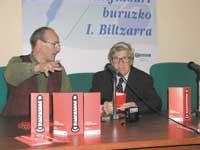
However, he has responded that he has no difficulty understanding whether this is something difficult for people, or whether it is not a small change from the classical approach. He believes that we have very hard social traditions and we love to see the history of life as something progressive and predictable, and that we see ourselves as leaders of development, of course. “It’s not a natural difficulty, I think it’s emotionally difficult.”
As a third difference we mentioned the number and nature of taxa. On many occasions, our perception is that taxa change from less to more and more evolved in the classical perspective. “Well, … in an extremely wide time, quite behind and starting with bacteria, but not in 500 million years. In 500 million years we have the same basic models.” They were also cordated from the beginning, “at least from the beginning of complex animals.” The number of films is also the same. “(…) Today there are more species, there are more types of animals, but the same main filumes have evolved good from the Cambrian era, with the exception of the Briozoans, which appeared in the ordobicial era (following the Cambrian). Otherwise, all the filums appeared very early in the history of life.”
Finally, leaving aside the theme of tacit balance, we mentioned Burgess Shale. It has been an important place in Gould's research. But, of course, most of us do not know it and we have asked those of us who are not paleontologists to tell us where it is and what it has. He has begun to praise himself saying that he is in Canada and that it is a very beautiful place, but the important thing is what has been preserved there. “Normally in fossil records only shells and hard fragments are found, and the degree of real diversity of aquatic fauna is not appreciated. But Burgess Shal has records after the appearance of the first living beings in all animal filums, and as the soft parts are very well preserved, you can appreciate the real diversity. That’s why it’s important.”
Darwin's evolution: a good starting point for understanding the taidado balance
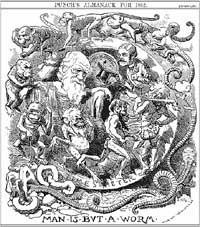
After a few years, almost everyone accepted this theory and today has enthusiastic followers. However, Gould and Eldgredg published about 25 years ago the theory of taid balance. This theory does not deny a slow evolution, but states that in the history of life there have been much faster speed interruptions and that virtually all complex types of life emerged from the beginning.
Man who likes to see things live
We talked about the cave of Altamira, because we know that I wanted to go to it. He explained that he was never in a cave. That all friends have told her that it is wonderful, that it is a beautiful experience, but that she was never.
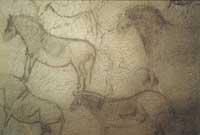

Gai honi buruzko eduki gehiago
Elhuyarrek garatutako teknologia



